
Prayer wheel
Encyclopedia

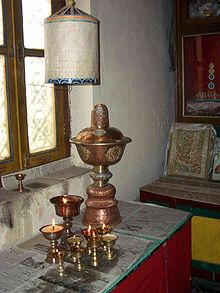
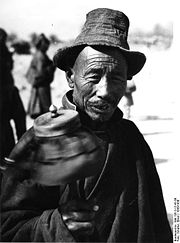
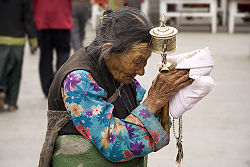
Wheel
A wheel is a device that allows heavy objects to be moved easily through rotating on an axle through its center, facilitating movement or transportation while supporting a load, or performing labor in machines. Common examples found in transport applications. A wheel, together with an axle,...
" on a spindle
Axle
An axle is a central shaft for a rotating wheel or gear. On wheeled vehicles, the axle may be fixed to the wheels, rotating with them, or fixed to its surroundings, with the wheels rotating around the axle. In the former case, bearings or bushings are provided at the mounting points where the axle...
made from metal
Metal
A metal , is an element, compound, or alloy that is a good conductor of both electricity and heat. Metals are usually malleable and shiny, that is they reflect most of incident light...
, wood
Wood
Wood is a hard, fibrous tissue found in many trees. It has been used for hundreds of thousands of years for both fuel and as a construction material. It is an organic material, a natural composite of cellulose fibers embedded in a matrix of lignin which resists compression...
, stone, leather
Leather
Leather is a durable and flexible material created via the tanning of putrescible animal rawhide and skin, primarily cattlehide. It can be produced through different manufacturing processes, ranging from cottage industry to heavy industry.-Forms:...
or coarse cotton
Cotton
Cotton is a soft, fluffy staple fiber that grows in a boll, or protective capsule, around the seeds of cotton plants of the genus Gossypium. The fiber is almost pure cellulose. The botanical purpose of cotton fiber is to aid in seed dispersal....
. Traditionally, the mantra
Mantra
A mantra is a sound, syllable, word, or group of words that is considered capable of "creating transformation"...
Om Mani Padme Hum
Om mani padme hum
is the six syllabled mantra particularly associated with the four-armed Shadakshari form of Avalokiteshvara , the bodhisattva of compassion...
is written in Sanskrit
Sanskrit
Sanskrit , is a historical Indo-Aryan language and the primary liturgical language of Hinduism, Jainism and Buddhism.Buddhism: besides Pali, see Buddhist Hybrid Sanskrit Today, it is listed as one of the 22 scheduled languages of India and is an official language of the state of Uttarakhand...
on the outside of the wheel. Also sometimes depicted are Dakinis, Protectors and very often the 8 auspicious symbols Ashtamangala
Ashtamangala
Ashtamangala or Zhaxi Daggyai are a sacred suite of Eight Auspicious Signs endemic to a number of Dharmic Traditions such as Hinduism, Jainism, and Buddhism. The symbols or 'symbolic attributes' are yidam and teaching tools...
. According to the Tibetan Buddhist
Tibetan Buddhism
Tibetan Buddhism is the body of Buddhist religious doctrine and institutions characteristic of Tibet and certain regions of the Himalayas, including northern Nepal, Bhutan, and India . It is the state religion of Bhutan...
tradition based on the lineage texts regarding prayer wheels, spinning such a wheel will have much the same meritorious effect as orally
Speech
Speech is the human faculty of speaking.It may also refer to:* Public speaking, the process of speaking to a group of people* Manner of articulation, how the body parts involved in making speech are manipulated...
reciting
Recitation
A recitation is a presentation made by a student to demonstrate knowledge of a subject or to provide instruction to others. In some academic institutions the term is used for a presentation by a teaching assistant or instructor, under the guidance of a senior faculty member, that supplements...
the prayers.
Nomenclature and etymology
Prayer wheel or Mani wheel . The Tibetan term is a contraction: "Mani" itself is a contraction of Sanskrit cintamaniCintamani
Cintamani also spelled as Chintamani is a wish-fulfilling jewel within both Hindu and Buddhist traditions, equivalent to the philosopher's stone in Western alchemy....
; "chos" is Tibetan for Dharma
Dharma
Dharma means Law or Natural Law and is a concept of central importance in Indian philosophy and religion. In the context of Hinduism, it refers to one's personal obligations, calling and duties, and a Hindu's dharma is affected by the person's age, caste, class, occupation, and gender...
; and "khor" or "khorlo" means chakra
Chakra
Chakra is a concept originating in Hindu texts, featured in tantric and yogic traditions of Hinduism and Buddhism. Its name derives from the Sanskrit word for "wheel" or "turning" .Chakra is a concept referring to wheel-like vortices...
no
Origins
The earliest recorded prayer wheels were written of by a Chinese pilgrim around 400 C.E. in LadakhLadakh
Ladakh is a region of Jammu and Kashmir, the northernmost state of the Republic of India. It lies between the Kunlun mountain range in the north and the main Great Himalayas to the south, inhabited by people of Indo-Aryan and Tibetan descent...
. The concept of the prayer wheel is a physical manifestation of the phrase "turning the wheel of Dharma
Dharma
Dharma means Law or Natural Law and is a concept of central importance in Indian philosophy and religion. In the context of Hinduism, it refers to one's personal obligations, calling and duties, and a Hindu's dharma is affected by the person's age, caste, class, occupation, and gender...
," which describes the way in which the Buddha
Gautama Buddha
Siddhārtha Gautama was a spiritual teacher from the Indian subcontinent, on whose teachings Buddhism was founded. In most Buddhist traditions, he is regarded as the Supreme Buddha Siddhārtha Gautama (Sanskrit: सिद्धार्थ गौतम; Pali: Siddhattha Gotama) was a spiritual teacher from the Indian...
taught.
Practice
According to the lineage texts on prayer wheels, prayer wheels are used to accumulate wisdom and merit (good karma) and to purify negativities (bad karma). In Buddhism, Buddhas and Bodhisattvas have created a variety of skillful means (upaya) to help bring practitioners ever closer to realizing enlightenment. The idea of spinning mantras relates to numerous Tantric practices whereby the Tantric practitioner visualizes mantras revolving around the nadis and especially around the meridian chakras such as the heart and crown. Therefore, prayer wheels are a visual aid for developing one's capacity for these types of Tantric visualizations. The spiritual method for those practicing with a prayer wheel is very specific (with slight variations according to different Buddhist sects). The practitioner most often spins the wheel clockwiseClockwise
Circular motion can occur in two possible directions. A clockwise motion is one that proceeds in the same direction as a clock's hands: from the top to the right, then down and then to the left, and back to the top...
, as the direction in which the mantras are written is that of the movement of the sun across the sky. On rare occasions, advanced Tantric practitioners such as Senge Dongma, the Lion-Faced Dakini, spin prayer wheels counterclockwise to manifest a more wrathful protective energy. As the practitioner turns the wheel, it is best to focus the mind and repeat the Om Mani Padme Hum mantra. Not only does this increase the merit earned by the wheel's use, but it is a mind-stabilization technique that trains the mind while the body is in motion. Intoning the mani mantra with mindfulness and the "Bodhicitta" motivation dramatically enhances the effects of the prayer wheel. However, it is said that even turning it while distracted has benefits and merits, and it is stated in the lineage text that even insects that cross a prayer wheel's shadow will get some benefit. Each revolution is as meritorious as reading the inscription aloud as many times as it is written on the scroll, and this means that the more Om Mani Padme Hum mantras that are inside a prayer wheel, the more powerful it is. It is best to turn the wheel with a gentle rhythm and not too fast or frantically. While turning smoothly, one keeps in mind the motivation and spirit of compassion and bodhichitta (the noble mind that aspires to full enlightenment for the benefit of all beings).
The benefits attributed to the practice of turning the wheel are vast. Not only does it help wisdom, compassion and bodhichitta arise in the practitioner, it also enhances siddhis (spiritual powers such as clairvoyance, precognition, reading others thoughts, etc.). The practitioner can repeat the mantra as many times as possible during the turning of the wheel, stabilizing a calm, meditative mind. At the end of a practice session, there is a Tibetan Buddhist tradition of dedicating any accumulated merits that one may have gathered during practice to the benefit of all sentient beings. Then Om Ah Hum 3 times. This is customary with Tibetans upon completing any Buddhist practice, including the practice of the prayer wheel.
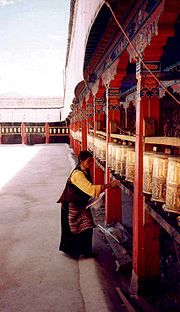
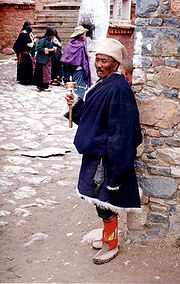
Thubten Zopa Rinpoche
Not to be confused with Geshe Lhundub Sopa Rinpoche, Geshe Tenzin Zopa, Lama Zopa Tharchin , and Geshe Lobsang Zopa ...
has commented that installing a prayer wheel has the capacity to completely transform a place, which becomes "...peaceful, pleasant, and conducive to the mind."
Simply touching a prayer wheel is said to bring great purification to negative karmas and obscurations.
Mani wheel
The Mani wheel, or the hand prayer wheel, is a cylindrical body mounted on a wooden or metal handle. The cylinder itself is weighted down with a cord or chain allowing it to be spun by a slight rotation of the wrist along with the mantra it contains.Water wheels
This type of prayer wheel is simply a prayer wheel that is turned by flowing water. The water that is touched by the wheel is said to become blessed and carries its purifying power into all life forms in the oceans and lakes that it feeds into.Fire wheel
This wheel is turned by the heat of a candle or electric light. The light emitted from the prayer wheel then purifies the negative karmas of the living beings it touches.Wind wheel
This type of wheel is turned by wind. The wind that touches the prayer wheel helps alleviate the negative karma of those it touches.Stationary prayer wheels
Many monasteries around Tibet have large, fixed, metal wheels set side by side in a row. Passersby can turn the entire row of wheels simply by sliding their hands over each one.Electric dharma wheels
Some prayer wheels are powered by electric motors. "Thardo Khorlo," as these electric wheels are sometimes known, contain one thousand copies of the mantra of Chenrezig and many copies of other mantras. The Thardo Khorlo can be accompanied by lights and music if one so chooses. However, Lama Zopa Rinpoche has said, "The merit of turning an electric prayer wheel goes to the electric company. This is why I prefer practitioners to use their own 'right energy' to turn a prayer wheel".Digital prayer wheels
The Dalai Lama has commented that animated GIFs on websites work just as well as other prayer wheels. As the GIF image turns, waves of compassion emanate in all directions to the surrounding area.Some have suggested that the spinning of a hard drive (several thousand rotations per minute) can act in similar function to a prayer wheel by saving an image of Om mani padme hum
Om mani padme hum
is the six syllabled mantra particularly associated with the four-armed Shadakshari form of Avalokiteshvara , the bodhisattva of compassion...
or other mantra on its local machine.
Internet-operated prayer wheel
This type of Prayer Wheel is a Stationary Electric Prayer Wheel which can be activated over a web interface. Before turning the wheel, a wish or a mantra can be entered at the web interface. Via a webcamWebcam
A webcam is a video camera that feeds its images in real time to a computer or computer network, often via USB, ethernet, or Wi-Fi.Their most popular use is the establishment of video links, permitting computers to act as videophones or videoconference stations. This common use as a video camera...
, the user can watch the wheel.
Prayer Wheel Apps
Four prayer wheels are currently listed as iPhone apps in the iTunes store. At least two of these prayer wheels can be activated, started stopped and reversed with a swipe of the thumb across the screen. One of these prayer wheels, called A Poetic Universe, dispenses wisdoms with matched images once the prayer wheel has been turned three times in a clockwise direction. No wisdoms are given to those who spin the wheel anti-clockwise.See also
- MaṇḍalaMandalaMaṇḍala is a Sanskrit word that means "circle". In the Buddhist and Hindu religious traditions their sacred art often takes a mandala form. The basic form of most Hindu and Buddhist mandalas is a square with four gates containing a circle with a center point...
- PradakshinaPradakshinaPradakshina or Pradakshinam , meaning circumambulation, consists of walking around in a 'circle' as a form of worship in Hindu ceremonies in India. The devotees walk around the sanctum sanctorum, the innermost chamber of the shrine housing the temple deity. It is done around sacred fire , trees and...
- Prayer beadsPrayer beadsPrayer beads are used by members of various religious traditions such as Roman Catholicism, Orthodox Christianity, Anglicanism, Islam, Hinduism, Buddhism, Sikhism and Bahá'í Faith to count the repetitions of prayers, chants or devotions, such as the rosary of Virgin Mary in Christianity and dhikr ...
- StupaStupaA stupa is a mound-like structure containing Buddhist relics, typically the remains of Buddha, used by Buddhists as a place of worship....
- Tibetan prayer flagTibetan prayer flagA prayer flag is a colorful panel of rectangular cloth, often found strung along mountain ridges and peaks high in the Himalayas. They are used to bless the surrounding countryside and for other purposes. Prayer flags are believed to have originated with Bon, which predated Buddhism in Tibet. In...
- Wheel of DharmaDharmacakraThe Dharmachakra , lit. "Wheel of Dharma" or "Wheel of Life" is a symbol that has represented dharma, the Buddha's teaching of the path to enlightenment, since the early period of Indian Buddhism. A similar symbol is also in use in Jainism...

